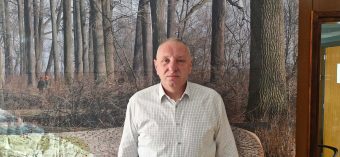As the world increasingly recognises forests as key allies in the fight against climate change, Serbia is recording a positive trend – forest cover today stands at 39 percent, with total green cover reaching 43.1 percent of the country’s territory. Behind these figures lie decades of planned afforestation, natural succession, and an increasingly robust institutional framework.

In an exclusive interview for Energy Portal Magazine, Saša Stamatović, Director of the Forest Directorate at the Ministry of Agriculture, Forestry and Water Management, discusses the results of the Second National Forest Inventory, the challenges of uneven forest distribution across regions, the importance of climate-resilient forest management, and major projects such as Forest Invest.
What is Serbia’s current forest coverage, what is the state of its forests, and what are the key factors influencing it?
— First and foremost, I must underline that forest area, along with many other quantitative and qualitative data about forests, is determined through a complex, robust, scientifically, methodologically, and statistically sound procedure known as the National Forest Inventory. Serbia completed its Second National Forest Inventory and published the results at the end of 2023, using the most advanced methodological and geoinformation technologies and instruments. FAO experts, under whose supervision the inventory was carried out, rated it a “high-quality study”.
According to data from the Second National Forest Inventory, conducted by the Ministry of Agriculture, Forestry and Water Management of the Republic of Serbia in cooperation with the United Nations Food and Agriculture Organization (FAO), Serbia has 3,025,471 hectares of forest and forest land, which amounts to 39.01 percent of its territory. When we add other land with tree cover (OLWT) – such as tree-lined avenues, smaller tree groups or individual trees, parks, and forest patches smaller than 0.5 hectares – which are not methodologically included in the official forest coverage figure, the total tree canopy cover reaches 43.1 percent. Although this latter category is not internationally defined as forest coverage, its importance and the need for preservation, especially in areas with low forest percentages and particularly in urban and peri-urban environments, are undeniable.
To properly understand the significance of this figure, we must look to the past and examine how forest coverage has changed over previous centuries. Historical estimates suggest that, at the beginning of the 19th century, over 50 percent of Serbia was covered by forest. This reflected the natural landscape before the widespread expansion of agriculture, livestock farming, and industrial development. However, by the second half of that century, following the country’s autonomy and the expansion of rural settlements into hilly and mountainous areas, there was significant population movement accompanied by growing demand for arable land and pastures. Forests were cleared to make way for agricultural production, especially livestock farming, and later for the development of infrastructure, mining, and industry, leading to a drastic reduction in forested areas.
By the end of the 19th century, forest coverage had decreased to around 35 percent, and just before the Second World War, it was estimated to have fallen to a mere 17 percent. This was the lowest recorded level and reflected the deep socio-economic and political processes of the time. Nevertheless, negative trends were already being recognised then. As early as 1839, Prince Miloš issued a decree legally prohibiting the felling and clearing of forests without supervision. The Forest Law of 1922, enacted during the Kingdom of Serbs, Croats and Slovenes, was the first to mandate reforestation of cleared land, signalling a move towards more active state management of forest resources.
The post-WWII period brought gradual change. As early as 1947, the state began allocating budget funds for afforestation, which, along with the cultivation of fast-growing species, gained momentum in the decades that followed. Alongside this, demographic trends – particularly rural depopulation and the decline of extensive livestock farming – led to the abandonment of pastures and meadows in mountainous areas. These unused areas underwent natural succession, meaning they gradually became reforested on their own. This process of natural succession has been one of the most significant factors behind the increase in forest coverage in recent decades. Alongside it, systematic afforestation, especially in barren and erosion-prone areas, has played an immeasurable role.
In the last ten years alone, through state and provincial programmes, more than 1.1 billion dinars of budget funds have been invested annually in afforestation and forest improvement, along with significant international funding through various projects.
IN FOCUS:
- Bihać – When Tourism Development Goes Hand in Hand With Care for Nature
- A Family Mission in the Service of Sustainability
- New Rules Shape the Pellet Market in Serbia
The third key element is the strengthening of the legal and institutional framework.
Today, deforestation is strictly prohibited by law and can only be carried out if there is a determined public interest. Illegal logging is treated as a criminal offence. There is also a strong inspection system in place, and all forest managers are required to implement protection and improvement measures for forest resources in accordance with current forest management plans.
The fourth factor contributing to the recorded increase in forest coverage is the modernisation of monitoring.
As part of the Second National Forest Inventory, a two-phase sampling system was used, combining field measurements with satellite imagery analysis (FAO Collect Earth). This method made it possible to record even small forest areas that previously remained outside statistical coverage. This means today’s data is not only better, but also more accurate.
A significant factor in this positive trend is also the growing public awareness of forests’ ecosystem functions, which has seen exponential growth in recent decades, particularly with the recognition of forests’ role in mitigating climate change.
To summarise, the current state of Serbia’s forests is a mirror image of its economic, historical, and cultural circumstances. It represents the result of a decades-long process of reversing degradation. This includes natural succession, organised afforestation, the retreat of agriculture from marginal lands, and a significant role played by regulatory mechanisms.
What activities is the Forest Directorate undertaking to increase forest coverage further, and is it involved in CO₂ emissions reduction projects?
— Since the 1980s, the optimal forest coverage for Serbia has been estimated at 41.4 percent, and this figure is officially included in the national Spatial Plan.

What’s the difference between an average percentage and an optimum? According to the Second National Forest Inventory (NFI2), forests in Serbia are not evenly distributed: over 94 percent of all forests are located in Central Serbia, while Vojvodina, due to its predominantly agricultural land use, has only 8.63 percent forest coverage. The most forested districts are Raška, Jablanica, Bor, Toplica, and Zlatibor. In contrast, the least forested are North Banat, Central Banat, and North Bačka – with Raška at over 67 percent and North Banat at just 0.2 percent.
The optimum for the republic, as a functional indicator, can only be determined bottom-up – that is, by calculating optimum levels for smaller spatial units and then aggregating them at the national level. An average value does not reflect spatial distribution – for instance, increasing forest cover in already heavily forested districts won’t improve the situation in Banat. This doesn’t mean afforestation shouldn’t continue where there is potential, even in areas with high forest coverage, but priority must be given to those with low coverage.
In any case, the optimum is a dynamic and primarily spatial-planning category that must combine natural potential with aligned ecological, economic, and social needs.
From a forestry perspective, a strategic stance can fully embrace the statement attributed to Jovan Jovanović Zmaj: “Wherever you find a good place, plant a tree there.” This means continuing to secure land for establishing new forests, financing new afforestation efforts, and preserving and improving existing forests.
In this sense, the seven-year Forest Invest project has just begun implementation, co-financed by the Green Climate Fund. The project is jointly implemented by the FAO and the Government of Serbia (via the Ministry of Agriculture, Forestry and Water Management, Serbia Forests and Vojvodina Šume public enterprise), with the aim of increasing forest resilience, ensuring energy security for the most vulnerable, and improving carbon storage. In brief, the project covers afforestation, conversion of degraded forests, nursery improvements, and the inclusion of the private sector in climate-resilient forestry and decarbonisation. It is planned that during the project’s implementation, 7,000 hectares will be afforested, 51,000 hectares of degraded coppice forests will be converted into high forests, climate-resilient forest management will be enabled on 500,000 hectares, firewood consumption among the most vulnerable households will be reduced, and emissions will be cut by 8.4 million tonnes of CO₂ equivalent over the next 27 years.
Interview by Milena Maglovski
The story was published in Energy portal Magazine Climate change



